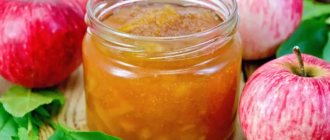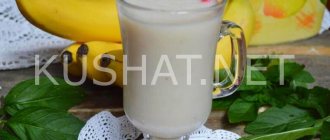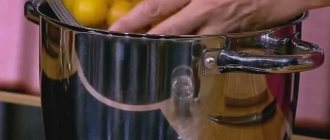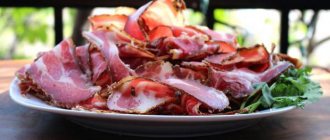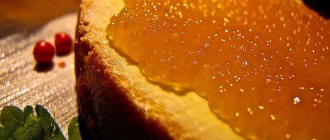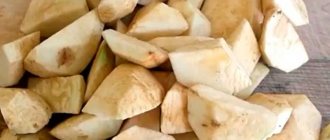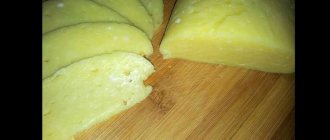Gourmet recipe
This recipe requires a lot of care and time, but it's worth it.
For it they use:
- 1.5 liters of water;
- 1 cup of sugar;
- 1.5 l jam
- 1 tbsp. l. (with top) raisins.
For preparation you will need a large container of 5 liters. Fill it only 2/3 full and no more.
First, we make the wort: add sugar and jam to boiled and cooled water, taste it, it should be sweet (but not too sweet, not cloying). If the sweetness is not enough, add some sugar.
Now we prepare a seal from cotton wool and gauze. To do this, put a layer (0.5 cm) of cotton wool in 2 layers of gauze and wrap it around the neck of the jar. Experts say that this way the taste will be special. If this is difficult, put on a rubber glove with a small hole.
We place the resulting composition in a dark and warm place; if it is not possible to put it in a dark place, you can cover the jar with a cloth.
Then on day 4-5 add sugar to the container. To do this, use a straw to suck out ½ cup of liquid from our container and dilute ½ cup of sugar in it. And then we return the liquid to the jar through a straw.
This procedure for adding sugar must be repeated again (again for 4–5 days). And then leave the container for fermentation for 1.5–2 months. The duration of the process depends on the room temperature.
If the fermentation process (the release of bubbles) does not stop after 2 months, you will need to pour the clear liquid into another prepared container and close it again with a shutter.
When fermentation stops, the liquid is filtered through cheesecloth and sugar and vodka are added (or not) to taste.
Then the resulting liquid is poured into the container to the top for aging. This process takes from 2 to 6 months (room temperature from 6 to 12 C). First, every 15 days the liquid is poured into another container to avoid sediment (it is left in the old container). After 2 months, this procedure can be done once a month, and then less often (as sediment appears). When the aging is complete, the wine is bottled and tightly sealed.
Store in the basement for up to 3 years.
Manufacturing stages
- The prepared container must be washed and doused with boiling water. Otherwise, the bacteria remaining on the surface will actively multiply and ruin the workpiece.
- Next, add all the necessary ingredients, cover with a clean cloth and take the container to a dark place with a temperature of 20–25 C.
- Over the next five days, the contents should be stirred from time to time with a wooden spoon.
- After this period, the infusion is filtered and poured into another bottle, also sterilized.
- After this, the young wine is left for final fermentation for 30-50 days, placed in a warm place.
Classic raspberry wine recipe at home
The classic recipe for making raspberry wine involves using only natural ingredients and excludes the addition of alcohol. Thus, the wine is infused in a natural way, degrees are formed in it through natural fermentation.
What ingredients will be needed?
To prepare you will need:
- 10 kg of fresh raspberries (the sweeter the berry, the better);
- 5.8 kg sugar;
- 7 liters of clean water.
Step-by-step cooking process
Wine is prepared like this:
- First, remove all the stems from the berries and place them in a large container (basin, large bowl).
- Add 5 kg of sugar and water to peeled raspberries.
- The resulting mixture is stirred, while the berries are crushed and pressed with your hands so that they release juice and the sugar is completely dissolved.
- The container with berry puree is placed in a warm place for 5-6 days to ensure active fermentation processes. From time to time, throughout the day, the composition is stirred to prevent mold from forming.
- After 5-6 days, the mass is decanted, squeezing the berry pulp well. The resulting liquid is poured into a large glass bottle so that it is approximately 3/5 full. If there is no large bottle, then you can pour the future wine into small bottles, also filling them 3/5 of the way.
- The bottles are covered with lids with holes and placed in a warm place where the product will ferment well.
- After 10 days, 400 g of sugar is added to the entire volume of the workpiece. If the wine is bottled in small bottles, this portion of sugar should be distributed evenly throughout the container. The wort is stirred and left to ferment further.
- After another 7 days, 400 g of sugar is again added to the drink, stirred and allowed to brew for another 10 days.
- The finished wine drink is strained and poured into clean containers using a silicone hose. In this case, the wine is not stirred so that sediment does not rise, and the hose is not inserted all the way so that the settled cake does not rise too much.
The wine is served chilled with cheese and fruit snacks.
Wine from fermented jam
If you find stocks of fermented jam in your pantry, do not rush to throw it away, because you can make delicious wine from it at home. The recipe is very easy and does not require any special material or physical costs.
Ingredients:
- any fermented jam - 1.5 liters;
- granulated sugar – 400 grams;
- water – 1.5 liters;
- raisins – 100 grams.
Preparation:
- Pour water into a saucepan and heat it to 40 degrees.
- Add a handful of unwashed raisins, jam and 200 grams of sugar to the liquid.
- Pour the prepared ingredients into a large jar or bottle, cover the neck of the container with a glove, and put the future wine in a warm place for 2 weeks.
- Strain the drink, add the remaining sugar, shake. Put it back in its original place for another three weeks.
After the time has elapsed, the home-made wine is ready for drinking.
As you can see, all the recipes are simple, now you know that your sweet preparations will not go to waste in any case. Having tried to prepare such an original and tasty drink at home at least once, you are unlikely to want to buy store-bought products.
https://www.youtube.com/watch?v=Q7WP9IcaDYY
Raspberry wine from frozen raspberries
Raspberry wine at home, a simple recipe for which does not take much time to prepare, can be prepared not only from fresh berries, but also from frozen ones.
What ingredients will be needed?
To prepare you will need:
- 2.5 liters of water;
- 230 g raisins;
- 3.5 kg frozen raspberries;
- 1.5 kg of sugar.
Step-by-step cooking process
Step by step steps:
- The berries are first left to thaw, preferably overnight.
- After defrosting, add refined sugar, raisins and clean water to the resulting berries and water. The workpiece is put in a warm place and covered with a lid.
- The sugar must completely dissolve and the berries rise to the top, after which the wort is filtered and the berries are squeezed out.
- The resulting liquid is poured into containers so that 30% of the container volume remains free.
- An air vent (hydraulic seal) is placed on the containers and placed in a warm place without access to bright light.
- After 30-40 days, fermentation should stop and the wine can be filtered and sent to steep in a darkened room for another 3 months.
This wine is served, as well as wine made from fresh raspberries, with a variety of meat and fish appetizers.
How to install a water seal?
An important point is the need to protect the wort from the influence of oxygen, while allowing carbon dioxide to be freely removed from the container.
To do this, you can use a special device - a water stopper, which is installed on the lid of the fermentation tank. As the pressure increases, the accumulated gas escapes through the water, which prevents oxygen from entering.
The water seal will also protect the wine from foreign microorganisms from the environment that can spoil the product. You can buy such a device in specialized stores; its price ranges from 100 to 500 rubles.
You can often find homemade water seals.
The most popular designs are:
- A thin glove with a hole made by a needle, placed over the neck of a bottle.
- A tube lowered into a jar of water.
- Design of disposable syringes.
How to make a water seal with your own hands is shown in the video:
Wine recipe without yeast
Wine from fermented jam can be made at home using almost any base in a month or a little more. It is preferable to use fermented canned food from the same fruits and berries. In this case, the taste of the wine will be more intense. Currant wine is especially interesting in this sense. When properly aged, it is not much inferior in taste to grape wines. Fortified drinks made from apple jam do not have enough flavor. To improve taste, they are usually reduced with blackcurrant jam. Raspberry jam can also be reduced by fermented canned goods made from other berries. The reason here is different: any raspberry products have a strong effect on the heart muscle. They can dramatically increase your blood pressure.
How to make wine from raspberry jam that does not burden your well-being?
The most optimal option looks like one that combines fermented raspberry and currant jam in a 50/50 ratio with a low sugar level in the final product. The basic principle of blending, leading to a balanced taste sensation, is the combination of sour and sweet. In an acidic environment, the effects of sugar are softened. Sourdough is the basis of any fermentation process from dough making to winemaking. The result is the formation of ethyl alcohol and carbon dioxide. Another thing is that there are different types of this catalyst. Some are fungal in nature and are called “yeasts,” while others are found in certain types of berries, such as grapes and raspberries. The difference between them is mainly in the fermentation activity and the smell that the starter brings to the final product.
It is preferable to make homemade wine from fermented jam using natural leaven. Without yeast, which gives wine an unpleasant fusel taste. The recipe for jam without yeast as it transforms into wine is as follows. Before making wine from fermented jam, syrup is boiled. A liter of water requires at least 500 grams of sugar. After the syrup has cooled, jam is added to it and stirred until smooth. To begin fermentation, grapes or raspberries are added to the prepared substrate. It should be borne in mind that grapes and raspberries must be unwashed. Their surface contains a natural yeast coating. The water will wash it away, and then the berries will lose their fermentation activity. Raisins are needed only when fresh grapes are not available. The effectiveness of raisins is not so high. Raisin-based wine ages for up to six months.
Tips for preparing the drink
Wine from fermented jam is prepared at home in containers that are not in contact with the wort. Do not use metal or plastic containers. They can spoil the taste of the drink and form substances harmful to the human body. It is best to stir the wort with a wooden spoon. It will not affect the fermentation process.
All containers used during preparation must be thoroughly sterilized. In dirty dishes, wine will not last long or may not cook at all.
Wine is not prepared from different types of jam, as the taste may deteriorate. To enhance it, fresh mashed berries are added to the wort.
How to make wine with raisins and rice at home from old currant jam
And another recipe for wine made from jam, but currant jam. Currants are very well used for making jam, both black and red. But mostly we cook it with black currants.
By the way, as practice shows, at least among my friends, blackcurrant jam often gets old. The rest somehow disperse quickly. So we will use this jam to make wine.
Currant wine is very original!
To make wine we need a liter of jam. Moreover, you can simply take black currants, or add red currant jam, if available. In general, blackcurrant jam is quite sweet, so it would be good to dilute it with sour red jam.
Then we need two liters of clean water and for fermentation 200 g of fresh grapes and the same amount of unwashed rice. Rice is used as a starter.
So, first of all, prepare the dishes. All glass containers wash very well with baking soda in hot water. Then they need to be doused with boiling water. You can do it a little differently: sterilize it in the microwave.
Take a large container, for example an enamel pan, and pour the jam into it. We prepare a fermentation solution from rice and raisins. To do this, dissolve 50 g of sugar in hot water - one glass, cool the resulting syrup to room temperature. Then add raisins and rice to the syrup. Leave the finished starter for some time to ferment. As soon as it ferments, add it to the jam, then add warm water and stir everything well.
All that remains is to put it in a warm and dark place for the first fermentation. This will happen in about 10 days. After 10 days, all the pulp will rise to the top and will need to be removed.
Remove the pulp from above and squeeze it out. We filter the liquid and pour everything into a new container, where the main stage of fermentation will take place. Pour the wort into a jar. Here you can add 50 g of sugar for every three liters of wort. We put a glove on the neck of the jar and pierce it. To prevent the glove from falling off, it can be secured with an elastic band. If you have a water seal, then install it accordingly.
Having installed a water seal or glove, place the container in a warm place for fermentation. You can also wrap the jar with a towel. But, if you make wine in the summer, then there will be plenty of heat, and in winter we place the container closer to the radiator. At least the temperature should be within 20 degrees Celsius. The place where we place the jar should also be dark, light should not fall on the fermenting wine. It will stay like this for at least 30 days.
The end of fermentation will be indicated to us by a fallen glove or sediment, and bubbles will also cease to be intensely released.
Let's move on to the next stage - separation from sediment.
We filter the wine through a hose, gauze, water filter, whatever is more convenient for you. Some people manage to simply pour the wine quite carefully, leaving sediment in the jar. Try it, maybe you will succeed and don’t bother with gauze and hoses.
While the wine is pouring, prepare new clean containers, pour the strained wine into them and place it in a dark place to clarify. This process lasts three days.
True, it won’t become much lighter, however, it’s jam after all. Precipitate may also appear during this process.
Then it is also removed, and the wine is poured into cleanly washed containers. Since this is the final stage, we prepare special bottles into which we pour the wine. We close them tightly with corks, preferably wooden ones, and put them in a cool place to ripen for three months.
At the end of this period, the wine will be completely ready, you can treat yourself to it yourself or treat your friends and acquaintances.
And let them say that this wine was made from jam, and not from fresh berries and fruits. If everything is done correctly according to the technology, then wine made from jam does not differ much from wine made from natural fruits.
So try it and share your impressions. Or maybe you have your own tricks for preparing such a drink.
Good luck everyone!
What to consider for a novice winemaker
It’s possible to make wine from different jams, except those that are too moldy. If plaque has formed only at the neck of the jar, you can carefully remove it with a spoon and use the remaining jam. But if, after removing the moldy islands, an unpleasant odor remains, you can no longer make wine from such jam. The candied raw materials should first be heated, dissolving the crystals. Instead of water you can use
fruit compote or juice from old home supplies? the alcohol will taste brighter.
When making a noble drink from winter preparations, you need to follow a certain technology. You can make adjustments to the recipe, but there are nuances that do not depend on the type of jam:
- The wine must ferment in special barrels. If unavailable, you can use glass bottles and jars with a volume of 3 to 10 liters. During fermentation, future alcohol should be hidden from light in a cool place. Otherwise the color will be faded, but the taste will be poor. overly tart.
- Jam and boiled water or compote are usually taken in equal proportions. That is, for 1.5 liters of liquid you need the same amount of raw materials. The amount of sugar depends on the sweetness of the jam, but with the above proportions, a glass is enough.
- For better fermentation, do you add unwashed raisins to the future intoxicated nectar? it contains grape yeast. If this ingredient is supposed to be soaked, then it must be added with water. Can I use grated raspberries? it will also give the desired effect. Or buy wine yeast and add 50 g per 1 liter of jam. They often cause foaming during the initial stages of fermentation, but this is not something to be afraid of.
- The strength of a wine depends not only on the fermentation time. Do connoisseurs of stronger alcohol need to take more yeast, raspberries or raisins? approximately twice. Do you want to turn things up even higher? Then the basis is taken not two, but three components in equal proportions: water, jam and vodka. This mixture is infused in a dark place for 20 days. After filtration, the resulting liquid is added to bottles of finished wine, making it fortified.
Gourmet recipe
This recipe requires a lot of care and time, but it's worth it.
For it they use:
- 1.5 liters of water;
- 1 cup of sugar;
- 1.5 l jam
- 1 tbsp. l. (with top) raisins.
For preparation you will need a large container of 5 liters. Fill it only 2/3 full and no more.
First, we make the wort: add sugar and jam to boiled and cooled water, taste it, it should be sweet (but not too sweet, not cloying). If the sweetness is not enough, add some sugar.
Now we prepare a seal from cotton wool and gauze. To do this, put a layer (0.5 cm) of cotton wool in 2 layers of gauze and wrap it around the neck of the jar. Experts say that this way the taste will be special. If this is difficult, put on a rubber glove with a small hole.
We place the resulting composition in a dark and warm place; if it is not possible to put it in a dark place, you can cover the jar with a cloth.
Then on day 4-5 add sugar to the container. To do this, use a straw to suck out ½ cup of liquid from our container and dilute ½ cup of sugar in it. And then we return the liquid to the jar through a straw.
This procedure for adding sugar must be repeated again (again for 4–5 days). And then leave the container for fermentation for 1.5–2 months. The duration of the process depends on the room temperature.
If the fermentation process (the release of bubbles) does not stop after 2 months, you will need to pour the clear liquid into another prepared container and close it again with a shutter.
When fermentation stops, the liquid is filtered through cheesecloth and sugar and vodka are added (or not) to taste.
Then the resulting liquid is poured into the container to the top for aging. This process takes from 2 to 6 months (room temperature from 6 to 12 C). First, every 15 days the liquid is poured into another container to avoid sediment (it is left in the old container). After 2 months, this procedure can be done once a month, and then less often (as sediment appears). When the aging is complete, the wine is bottled and tightly sealed.
Store in the basement for up to 3 years.
https://youtube.com/watch?v=TV9erMU2AU4%3Ffeature%3Doembed
If the jam has fermented, what should I do?
If the housewife realized it in time, the jam did not become moldy and the sour smell was not too noticeable, then the situation can be corrected quite easily. Using a colander, you need to separate the syrup from the berries, then add sugar to the solution at the rate of 1 cup of sand per 1 liter of syrup, and boil it all. When a drop of syrup begins to hold its shape, add berries to the bowl and cook for another 15-20 minutes. The jam has been saved, but it should be consumed immediately.
If the jam has fermented, what should I do? To correct a very sour product, you can add soda during additional cooking; 1 teaspoon is enough for one liter of jam.
It is not recommended to eat moldy jam. Of course, you can remove the top layer of mold and finish the ill-fated jar, but in this case you shouldn’t be greedy. The fact is that the mold that affects the product consists of threads. The visible part is formed on the surface, and the invisible one penetrates deeper. It is impossible to determine by eye how spoiled the jam is, and food contaminated with mold spores can cause significant harm to health.
The main reasons for this problem are saving sugar, reducing cooking time and packaging the jam in wet jars. By the way, many housewives mistakenly believe that any berries are suitable for jam, even with visible defects, they say, everything will be digested anyway. This is wrong. The berries must be selected very carefully, and any damaged ones should be thrown away.
An indicator of the readiness of the jam is the transparency of the product and the uniform arrangement of the berries in the syrup. If the fruits float on the surface or, conversely, are located at the bottom, this means that the sweet delicacy is not ready, and cooking should be continued.
If the jam has fermented, what should I do? There is another great way to process it - to make delicious homemade wine. You will kill two birds with one stone: your work will not be in vain and you will get additional pleasure. The rules of winemaking in this case are almost the same for all berries. The jam should be poured into a large jar, add water, approximately the same amount by volume, granulated sugar and a few raisins. You need about half a glass of sugar per 3 liters of mixture, and about 1 tablespoon of raisins.
Mix everything, put a rubber glove on the jar and place the container in a warm place for three weeks. At the end of this period, the solution is filtered, a little more sugar is added and the drink is bottled. After 2-3 months the wine is ready.
What to do if raspberry, currant, or strawberry jam has fermented? This will be discussed further.
How to make homemade wine from old raspberry jam
This is an option for making wine from raspberry jam. Raspberry jam is very common in our pantries. It is mainly used as a medicine for colds in winter. Therefore, raspberry jam can be stored for a long time, which we can sometimes forget about. As a result, it becomes old and loses its properties. By the way, it is also possible that you almost ate the jam, but there was little left and you forgot about it. When they discovered it, it was no longer suitable for food. But don’t throw away this jam, even if it’s not enough. Of course not! Let's make a wonderful raspberry wine from it.
But first, let's talk about proportions. There are no strict rules here. But most often they do it in a ratio of 1:5, i.e., a liter of jam per five-liter jar. So we will proceed from these proportions.
If you have 300 grams of jam left, then this is a two-liter jar. Take a clean jar and pour the jam into it.
The main thing in all this action is that the jam is mold-free. If there is even a little mold on it, you will not receive wine.
So, we poured the jam into a two-liter jar. Next, add two liters of clean, not tap water. Nothing else is needed, especially sugar. The jam was already made with sugar, so there was plenty of it there.
As for yeast, you can either add it or not. The option of making wine from jam with yeast will be discussed a little later. Here we will do without them.
We do not pour water to the very top of the jar, but a little more than 2/3. There should be free space left up to the edge of the jar.
Now we install the water seal. There may be options here. Firstly, the simplest one is a glove. But there may be a water seal that is installed in the lid, or you can make it yourself. A hole is cut in the lid, one end of the hose is inserted into it, and the other is lowered into a bottle of water.
The picture shows two options for such water seals. In the foreground is a jar with a commercially available water seal installed in the lid. In general, choose for yourself; each of the three options will be suitable.
So, we installed a water seal, now we set it to fermentation. The fermentation time for jam can vary from a month to two
However, you should not pay attention to this; you need to monitor when bubbles stop forming and a precipitate appears. This means that the fermentation process has completed
Now you need to remove the wine from the sediment. This is done using a silicone tube, which we lower into the wine without touching the sediment and only pour the liquid into another prepared container. All containers must be glass.
So, we poured it into containers, such as bottles.
Now we let these bottles mature for three months. In principle, you can leave it for even longer, this will not make the wine worse. The main thing is to place the bottles no longer in a warm place, as at the fermentation stage, but in a cool room. This could be a cellar or basement. You can also use a refrigerator. Cooler temperatures prevent re-fermentation from occurring.
In this form, it ripens, as already mentioned, for at least three to five months. After this, the finished wine can be poured into a more beautiful container and stored. And only then, if necessary, take it out and taste it.
I repeat once again - here we have given a variant of wine made from raspberry jam, but you can make it similarly from any other jam.
Is it possible to make wine at home from old candied or soured jam?
A person who is a professional winemaker will be very skeptical about wine made from homemade jam. And this is not surprising, because if you compare wine made from fresh fruits and from jam, the latter will be somewhat inferior in taste.
But there are times when there is a lot of jam left at home that has been stored for quite a long time, and it’s a pity to throw it away. Here it is important to understand how old the product is and how high quality it is.
If you are wondering how to make wine from jam at home, which will be intoxicating with its strong taste and aromatic aroma, then it is best to choose good fruit or berry jam, even if it is candied or last year’s. But if it begins to deteriorate (mold has appeared or is highly fermented), then do not even think about starting to prepare the drink.
ATTENTION! Wine can be made from jam if it has just begun to sour, but in no case from sour wine. Taking the latter will only transfer the products.
Required Products and Tools
To make homemade wine from sour jam, you don’t need many ingredients. You will need an old or sour sweet treat. You need to take a preparation from one type of berry or fruit. This is the only way to achieve a rich aroma and taste. When using sweet and sour berries, they will complement each other.
Instead of yeast, raisins are used: the missing delicacy and yeast will make mash. If the cooking recipe specifies yeast, then you need to use only wine yeast. They are difficult to find in stores, but still real.
During the preparation process you will need glass bottles. They can be 3 or 5 liters in volume. They need to be filled to no more than 4/5 of the volume, and the ideal option for filling is 2/3 of the total volume. The remaining space should be left for the fermentation process. A special water seal is required.
It will require a plastic lid, a needle with a dropper tube, and a container filled with water. The needle is stuck into the lid, and the end of the tube is lowered into the water. This design is called a “hydrolyzer”. If you are unable to make such a device, you can replace it with a medical glove. Such devices must be used to ensure that air does not enter the container with the wort.
You will also need the following devices:
- Medium size tube.
- Clean bottles with cork stoppers.
- Colander.
- Gauze.
Glass containers must be sterile. Thanks to this, you will get the original aroma of the drink and a pure taste without impurities.
How to make a drink at home?
The process of making wine is not distinguished by any specialties, but requires strict adherence to technology.
Here are the points that must be taken into account when making the drink:
- Give preference to an enamel or glass container that is suitable in size. You should avoid using iron or plastic utensils so as not to spoil the taste of the future drink. The ideal option would be a glass bottle, sterile and dry.
- Do not use tap water; it is better to use spring or bottled water.
- In the case when wine is made from jam, granulated sugar can be omitted or a little added, focusing on the initial sweetness of the raw material and the desired taste of the drink.
- Young wine needs aging. The container should be kept in a dark place for at least 3-4 weeks, waiting for ripening.
- Unwashed raisins enhance fermentation. Black varieties should be used.
Important! Do not use brewer's or bread yeast in recipes with wine from jam; use raisin starter, or buy special wine yeast.
It is better to prepare homemade wine from jam made from only one type of berries , this will allow you to fully reveal the taste of the finished drink. If you plan to use several types of jam, combine sour and sweet varieties. So that their tastes complement each other.
Rules for storing homemade wine from jam
Often, wine may not be tasty enough not only due to failure to follow the technology, but also due to violation of storage rules.
The most important thing to remember: Remember, all containers that you use in the process of making your masterpiece must be clean. This applies to jars, fermentation bottles, and bottles. Homemade jam wine is ideally stored at a temperature of about 100C
Therefore, the room temperature may be high and the refrigerator may be excessively cold. Remember this, it’s not for nothing that all winemakers store their wine in cellars. There is no need to assume that a simple wine made from jam has already aged sufficiently if the period is quite short. Don't rush into the result, wine loves calm. An aging period of about 3 months guarantees not only excellent taste, but also excellent aroma. If, during storage of homemade wine, the cork spreads and the bottle becomes depressurized, then the wine can be considered spoiled. To do this, store bottles exclusively horizontally. Protect containers from shock and temperature changes. Do not pour unfinished wine. Remember that fresh wine always spoils when it comes into contact with already drunk wine. You should not regret unfinished wine, only protect new bottles. Wine that has already been started can only be stored in the refrigerator for a few days.
Don't forget that knowing how to make simple wine from jam at home and preparing it is only half the battle. Proper storage of it is actually half of the task; it is careful handling that guarantees an unsurpassed aroma and great taste.
Its shelf life also depends on compliance with all rules for storing wine; if homemade wine from jam was stored carelessly, temporary depressurization was allowed, or temperature conditions were not maintained, it deteriorates very quickly. Good luck to everyone in this interesting business, excellent results and remember: making wine is an art, the key to success is to go through trial and error
Good luck to everyone in this interesting business, excellent results and remember: making wine is an art, the key to success is to go through trial and error.
Every year, thrifty housewives have at least a few jars of last year's jam left over. I don’t want to eat it anymore, since a new one has been prepared, and it’s a pity to throw away a natural product, the preparation of which took effort and money.
I suggest the next solution is to make homemade wine from jam. We will consider the recipe and technology further.
I advise you to find in advance a three-liter jar, a nylon lid, gauze and a medical rubber glove (you can install a water seal instead). In this recipe we will do without yeast, since wine yeast is difficult to get, and ordinary pressed or dry yeast is not used in winemaking, turning the wine into an ordinary mash. The role of yeast will be played by raisins, on the surface of which the necessary fungi live.
For making homemade wine
Suitable jam from apples, currants, raspberries, strawberries, plums, cherries and other fruit crops. But I do not recommend mixing different types of jam in one drink: the unique taste of each berry is lost in the mixture. It's better to make several separate servings.
Ingredients:
- jam – 1 liter;
- water – 1 liter;
- unwashed raisins – 100 grams;
- sugar – 10-100 grams per liter of water (optional).
The amount of water depends on the sugar content in the jam (natural in the raw material and added during the cooking process). We must strive to ensure that the sugar content in the wort does not exceed 20%. If necessary, dilute with more water. If the jam is not initially sweet, you can add more sugar.
How to make wine from jam: useful tips
Wine from chokeberry jam under a water seal
If you are trying yourself as a winemaker for the first time, it is worth considering the basic rules and secrets of professionals. To make good wine from old jam, you need to remember that:
- Always use well-cleaned glass fermentation containers that have been treated with steam or boiling water. This is necessary in order to kill all microbes that can disrupt the cooking process or spoil the taste of the drink;
- Special wine yeast is an indispensable product for speeding up the fermentation process, but if you can’t find it, then regular yeast is also suitable for baking (the resulting drink may have a different aftertaste depending on the yeast);
- When mixing different types of jam, you should follow the rule: sweet to sweet, and sour to sour;
- Water for diluting jam should be used boiled, but not hot, as high temperature will kill active bacteria necessary for good fermentation;
- It is best to store the finished drink in a glass or wooden barrel. It is not recommended to use plastic, since the alcohol formed during the fermentation process, when reacting with plastic containers, can release toxic substances.
It is important to know that during the cooking process you should not fill the container to the very top. The liquid must fill two-thirds of the volume in order for the fermentation process to proceed correctly. And the neck of the bottle can be closed either with a special water seal or with an ordinary sterile latex or rubber glove.
Winemaking from jam: main principles
The wine made from raspberry jam, beloved by many ladies, will turn out tasty and healthy from almost any raw material. So, in home winemaking, raw materials with an expired shelf life - one or even two years ago - are useful!
- Raspberries, ground with sugar, which have not stood the test of time and have fermented, will also work. Experienced home winemakers claim that wine made from sour raspberry jam is no worse than from fresh berries.
- If even the slightest hint of mold appears on the jam, it must be disposed of without regret and immediately. Working with such risky raw materials is a thankless task that may not be successful. Plus, mold is dangerous to your health, so don't take the risk.
- All utensils and instruments that we will use to make homemade wine from fermented or sour raspberry syrup must be sterile.
- In the absence of professional water seals, it is quite possible to use rubber medical gloves to control the fermentation process, but be sure to use new ones.
- To make raspberry jam wine tasty and healthy, you need to strictly adhere to temperature recommendations. But the amount of sugar suggested in recipes can be varied based on your own taste preferences.
Raspberries are a rather sweet berry, so to obtain a dry variety of homemade wine drink, you can add a little more sour jam, for example, cherry or currant, to the wort at the fermentation stage.
We will get an incredible aroma and a very pleasant, unsweetening taste!
In home winemaking, any utensils are used except metal ones, since they are prone to oxidation.
Ingredients
- Raspberry and currant jam – 1.5 l.
- Warm boiled water – 1.5 l.
- Sugar – 2.5 cups.
- Homemade wine yeast – 2-3 tbsp.
- Dark unwashed raisins – 1 handful.
- Clean water - 1 glass.
How to make homemade wine from raspberry jam
- First, let's “grow” homemade yeast. To do this, slightly heat half the water, dissolve sugar in it, cool, and add the rest of the water.
- Pour unwashed raisins into a sterile wide-necked bottle and fill with sweet water. The total volume of the mass should not exceed 2/3 of the capacity of the vessel.
- Having sealed the bottle with something that allows air to pass through well, place the container in a fairly warm place. You can place it on a sunlit windowsill (in summer) or closer to the radiator (in winter).
- During the day, the contents of the jar need to be shaken - this way the floating raisins will always be moist and will not become moldy. After 4-5 days, vigorous fermentation will be completed - the yeast is ready. The unused part can be stored for no more than 10 days and only in the cold.
- Now let’s start making wine with raspberry jam. Mix water at room temperature and jam, add half the sugar. When the grains dissolve, add the yeast and stir. Cover the bottle with gauze and put it in a warm place for a couple of weeks.
- When bubbles stop forming in the container and the smell of mash disappears, and the pulp (berry pulp) rises to the top, you can filter the semi-finished drink.
- We taste it and add, if necessary, more sugar, dissolving some of the expressed liquid, and then pour it back.
- We put on a glove and send it out into the warmth to wander some more. The glove is deflated - fermentation is over.
We pour the almost finished homemade wine into bottles, leaving the sediment in a large container, close it - and ripen in the dark and cool! During the process, we will periodically drain the wine from the sediment into fresh, clean containers.
The strength of the finished wine can be increased by adding alcohol in an amount from 2 to 15% of the total volume of liquid.
The drink is fixed before it is sent for aging. It should be borne in mind that the more alcohol in the wine, the harsher its taste will be.
Any product made with your own hands usually turns out not only tasty, but also healthy. The same can be said about wine made from raspberry jam, if you know how to prepare it at home and store it correctly.
No store-bought drink can compare with its unsurpassed taste and delicate aroma! So don’t rush to throw away your old twists - they may still come in handy...
Some storage tips
In order for the homemade wine you prepare to be tasty and retain its taste for a long time, you should adhere to a number of rules:
- Store wine in dark glass containers, preferably bottles.
- The optimal temperature for storage is 10–12 C and without lighting, direct sunlight is completely excluded.
- The bottles are closed with cork stoppers and stored horizontally. This way the cork will not dry out and air will not get into the bottle.
- In the room with wine, a stable temperature should be maintained; temperature changes are unacceptable. Bottles should not be moved; it is better not to move them at all, and especially not to store them in a room where there is vibration.
